Cameras and equipment for Solar System imaging in 2014
Year ago I wrote about cameras for 2013 and it's time to write about cameras and equipment for 2014. Things that had a successful start in 2013, or should be interesting when they show up in 2014 and so on. It's time to list and comment on some Solar System imaging hardware.
Cameras
Winner of 2013 - MT9M034 and ASI120MM camera
Aptina/Micron sensors were in the low end, in guiders that did good at guiding but were bit to noisy, and not so sensitive for planetary imaging. They also have problem with Sun H-alpha imaging. Surprisingly a good sensor showed up - MT9M034. When first ASI120MM cameras (and QHY5L-II) went into telescopes a lot of good images and positive reviews showed up. Many top planetary photographers picked ASI as their camera of choice. ZWO ASI120MM is the 2013 winner. The price is low (bit more than a half you would pay for DMK21AU618), the performance is good, FireCapture supports it and it's more universal camera as it has more pixels handy for lunar imaging. MT9M034 has a 1280x960 frame in a 1/3" diagonal. The pixels are smaller - 3.75µm. At full frame and USB2 the camera can record at up to 35FPS (more on smaller frame). As the pixels are quite small optimal f-ratio is also brighter something around/above f/14-15 (where f/20 would be for 5.6 pixels in ICX618).
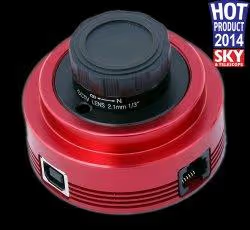
Although many picked ASI120MM not everybody liked it completely over ICX618 based camera. Some prefer Sony CCD for it's more softer noise, giving them better images in more challenging bands. CMOS tend to give pixelish noise, and sometimes you can also get vertical lines if the stack is noisy (visible usually on bias frames and dark frames). ASI120MM is good but some still prefer ICX618 based cameras. There is no clear winner.
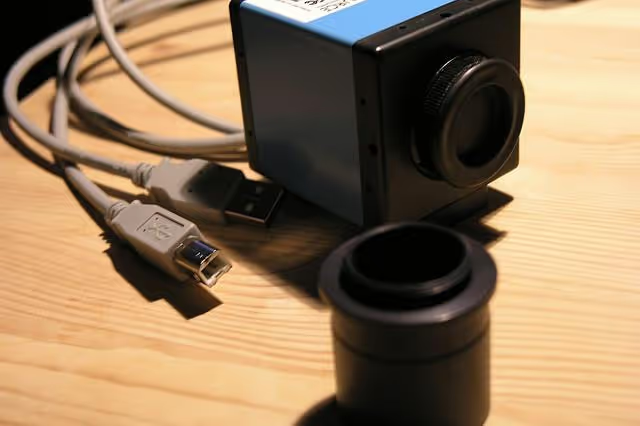
Celestron and TIS join forces - Celestron Skyris
The Imaging Source, maker of DMK, DBK, DFK cameras joined forces with Celestron. As a result we got Celestron Skyris USB3 cameras. Equipped with ICX618, ICX445 and ICX274 sensors they were designed to rock the market. In USA the prices are similar to those for older USB2 DMK/DFK/DBK models. In Europe the prices are higher and the cameras are available only in some shops. ICX618 camera went from 60 to 120 FPS. ICX445 offers 30 FPS while ICX274 20 FPS. Initial reports and images show that they don't generate any artifacts and they do seems to work.
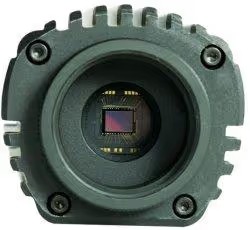
When announced they got some buzz on the forums. After that it faded. Either they are not so hot or there was some information missing on the start (like the artifacts issues, lack of information about the custom capture application etc.). At the moment Skyris cameras are supported by Genika, and on Celestron page they also list FireCapture (although FireCapture site don't list them).
Are they a hot product? 120 FPS for ICX618 looks nice, but it would be very hard to get planets bright enough to use more than standard 60 FPS (it's sometimes possible if you use high gain on a bright mono channel). That isn't a big selling point. ICX445 Skyris is faster than PGR Chameleon, and ICX274 is giving its max speed, although not as high as we would want to see. Those two cameras are targeted at solar photography and some customers already got them - but I didn't saw that much of an interest in them. Maybe in summer we will see something more.
ICX274 has a lot of pixels, but it's slow and quite old now. EV76C560 is much cheaper but has less pixels. USB3 Ximea xiQ MQ013MG-E2 offers 60 FPS (as well as PGR Blackfly with that sensor). There are also CMV4000 and CMV2000 sensors. The CMV4000 is quite expensive but you get 90 FPS at 2048x2048 frame in Ximea MQ042MG-* cameras. There are also quite expensive big Sony CCDs in Point Grey Grashopper 3 cameras that have a noticeable user base among solar photographers.
Summary: Celestron targeted very challenging market of solar system cameras with a partner that is well known, but not for being innovative and first on the market. The cameras do work, but they somewhat aren't that much interesting. USA users probably will see them more attractive than those in Europe.
Time for cooling - i-Nova cameras
Cooling among planetary cameras is rare. Only QHY IMG0H has it by default. There are however some user-made modifications to cameras like ASI120 that add Peltier cooling. French i-Nova cameras got a cooling kit that will cool the sensor down to around 0C. It works for all existing i-Nova cameras including i-Nova PLB-Mx2 equipment with the same sensor as award winning ASI120.
Cooling may be handy when we will want to do some DS imaging with a planetary camera, for guiding maybe. It will be also handy for dark planetary bands like methane band. It will be also interesting to compare noise for plain RGB imaging (does it improve the stack quality). In solar imaging it may prevent camera heating.

i-Nova cameras are quite popular among French photographers. They are also gaining more international interest and can be found in other counters (like in Altair Astro, Astroshop.eu shops). They are not supported by FireCapture but they come with their own PLXCapture. We can pick multiple models, including ICX445 and ICX618 ones.
Summary: cooled cameras are a thing to look at in 2014. It could be a handy aid in Neptune, Uranus or methane band imaging. There may be more cooled cameras than i-Nova and IMG0H - but time will tell if and when they will show up. Either so i-Nova cameras are an interesting product. Not as cheap as for example ZWO cameras, but still with good features and some very good photographs on the web. It would be nice to test and review one of their cameras and the PLXCapture software.
New Sony CCD - ICX693
Not so long ago I've tested Point Grey Blackfly BFLY-PGE-05S2M-CS with Sony ICX693. This camera and sensor was also tested by some japanese photographers. They made a direct comparison with ICX618 and it turned out that the new sensor is quite good. There is a noticeable improvement in UV. The camera is available in Point Grey stores at a relatively low prices. GigE camera offers 50 FPS for a 808 x 608 frame. The pixels are quite big - 6µm. Those should be handy for very slow telescopes. The frame is also bigger than ICX618 so framing planets will be easier even for bigger telescopes. But still it's not a big lunar sensor. It would be very nice to see this camera in action and to see those new Sony CCD sensors in new planetary cameras.
Aside of new Sony CCD sensors there is a growing user base of bigger Sony CCDs. Cameras like PGR Grashopper 3 cost more than $1000 but are rated by some as the best for solar imaging. Some of them are also used for planetary imaging with very big telescopes. It's a good way to have the same sensor in your DS as well as in planetary camera :)
Low cost cameras
There is a quite new ASI034MC on the market and it costs bit more than a top shelf MS Lifecam Studio webcam. It's to early to say how good it is, but many people are buying or asking about it at the moment. It should manage on Jupiter and probably Mars. If first mass imaging will be done on Saturn from northern hemisphere it may hurt as low altitude Saturn will be blurred by atmospheric dispersion (yellow visual filter could help, or 3 times more expensive dispersion corrector).
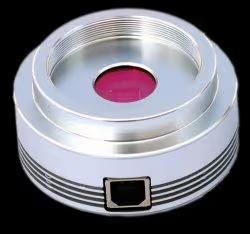
Among cheap mono cameras we have Firefly on ebay. Those are available there for more than a year. I wrote about them in the 2013 article and they are still here for the taking. The low gain problem got a workaround, but still it's an entry level mono camera. For that price it's super awesome. You can check my review too.
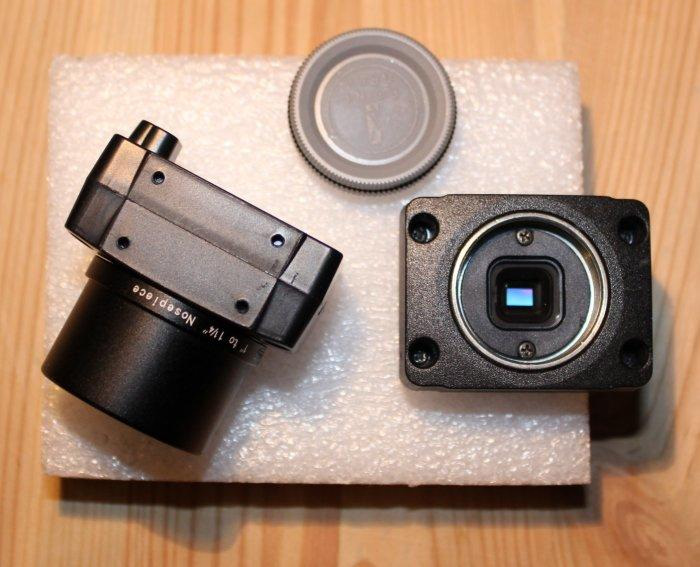
Disappointments of 2013
I'm using an IDS Imaging camera equipped with e2v EV76C661 CMOS sensor. There should be also EV76C660 similar sensor with ~80% QE and 3e read noise. The sensor is still nearly non existing. Furthermore it was tested by one of camera makers and turned out to be very noisy on high gain and longer exposures (similar to *61). Both sensors give very good planetary cameras - if they are running at low gain on bright bands, like LRGB. The older EV76C560 has not such problem. It seems that all NIR-enchanted sensors like the e2v Ruby like or CMV4000 NIR version suffer from higher dark current / shot noise. Strong cooling would help, but I don't know if that cooling would allow to take advantage of that insane sensitivity of EV76C660. That's quite disappointing. A comment on image-sensors-world.blogspot.com i'd hate to be the one to measure the dark current... seems to cover it nicely.
A new Sony CMOS is out - IMX174
Point Grey announced a new camera with Sony IMX174 CMOS sensor. 1920 x 1200 frame at 162 FPS with 5.86 μm pixels. Seems like a badass, but still looking at the previous chapter - I'm skeptical (global shutter is much worse than rolling shutter in e2v sensors, but Sony has probably different design). The previous IMX sensors weren't that hot, although they were low on noise. Some companies even made low gain and slower cameras dubbed as Scientific CMOS cameras (although not having real sCMOS sensor). I'm still waiting for some dark frames from Point Grey. Some probably already ordered this or other camera with that sensor, so we will see what's it worth.
Telescopes and accessories
Atmospheric dispersion correctors
For northern hemisphere upcoming years will be very hard. Jupiter will be lower and lower, while Mars and Saturn are already low. Low altitude means atmospheric dispersion which will prevent getting clear focus of the planet. Color cameras will be mostly affected, while mono cameras can refocus each channel to limit dispersion effect (but still they won't be able to use wide luminance bands, only infrared).
Atmospheric dispersion corrector can cancel out the dispersion allowing for a clear focus even for the L filter in a mono camera. Those correctors aren't cheap and are offered by two companies: ASH and Pierro Astro. If you have a big telescope you should start thinking about getting one in the not so distant future.
New telescopes and new ideas for some new telescopes
There was no revolution in telescopes in 2013 and there won't be rather any in 2014. Some could notice that there is more C14 and other big telescopes at use at the moment. There are however some new technologies that could be used to make planetary telescopes of tomorrow. Vitastra offers small schiefspieglers, but they may be able to roll out something bigger with either 2 or 3 mirrors. That design has no obstruction and uses tilted mirrors. If out don't like the corrector plate in a SCT you can take a look at the GSO RC which have quite big obstruction but should be quite good for planetary imaging too. As people wrote on cloudynights in a discussion about obstruction - it's not as evil as it might look like. RC telescopes aren't maybe dedicated for planets, but if you have one... GSO RC come in few sized up to 12", but a 16" is in the making. They have longer OTAs than those in SCTs.
Fast and very big Newtonian are used in planetary imaging. They require quite strong mounts and a lot of space to manage it (an observatory or alike). If the weight would be limited a very big Newtonian would still be ok for EQ6. If the OTA would be ultralight it could save a lot of space needed for handling and storage. litescope.net offer such travel Dobsonians. They are ultra light and ultra fast. Such OTA when equipped with a dovetail could be handy at planetary imaging (although quite experimental). A big Newtonian can also be put on a Dobsonian mount and an EQ platform. That saves a lot on a big EQ mount, but needs some experience and good EQ platform to get smooth tracking. That idea shows up here and there. Emil is using a 400 mm mirror that way. Also ZWO has truss Newtonian that are relatively lightweight.
Most of the mass will go into primary mirror. At some point the mirror will weight more than EQ6 and alike mounts can handle. Companies like normandfullumtelescope.com or hubbleoptics.com offer composite or sandwich mirrors of reduced weight. What about 4kg for a 14" mirror? Such mirrors aren't cheap but could bring more usable, non-stationary telescopes bigger than 14". Note that this is very experimental.
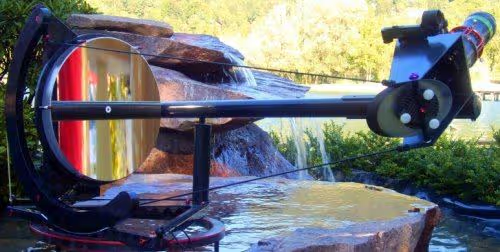
Comment article